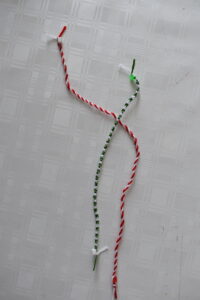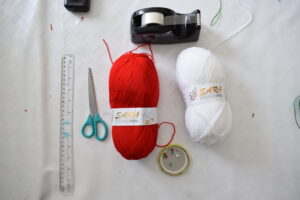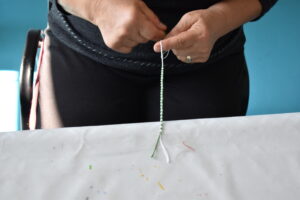The rite of wearing verore (summer bracelet) originates from a very ancient festivity, the Summer Day holiday. This event is related to honoring nature and the vegetation starting to vigorously thrive at this time. The Orthodox community celebrates it on March 1, according to the Julian calendar, while the Muslim community celebrates it on March 14. This event heralds the beginning of spring and the wish for a life filled with joy, love, and prosperity after the winter. The celebration begins on the last night of February with the lighting of bonfires. People around there jump over the fire passing wishes which vary by province. On this festive day, people wear the specific verore which symbolizes hopes for abundance and good crops.
A typical verore is made up of two strands of yarn going through a very simple making process:
The two yarns are red and white.
Both yearn are cut to the same 30-35 cm length. These strands of yarn are wrapped around one another at one end creating a kotkë (knot) and a bead is placed through. While on the other end, the two yarns come apart. Once each yarn is twisted separately, the other end is brought together and knotted again. A bead is also placed through on this side. Next, the yarn is let loose, and the two strands are twisted with one another. This type of resulting thread is used to make these summer bracelets and even rings. Usually, verore is worn on the hand, while children wear it also on the feet, with the aim of having good luck and not stumbling down.
At the moment when the summer bracelet is worn, people usually wish: “… (child’s name) may cross over, and … (someone we don’t like) may stumble down!” For example, “May Doneli cross over, may Beni stumble down!”
The Orthodox community wears the verore or summer bracelet the day before official Summer Day (the night before March 1) and takes it off on March 25 (Evangelism Day), while some other people believe it should be taken off when that person sees the first swallow.
The Muslim community use white and red strands of yarn, made into bracelet the same way, but wear them on the night before March 14, and take it off on March 25.
The Bektashi community uses white and green strands of yearning to make the summer bracelet. They take it off on March 22.
It has become a custom that as soon as summer bracelets are taken off, they are hung on a tree or roses, believing it that swallows will likely come and take them away.




